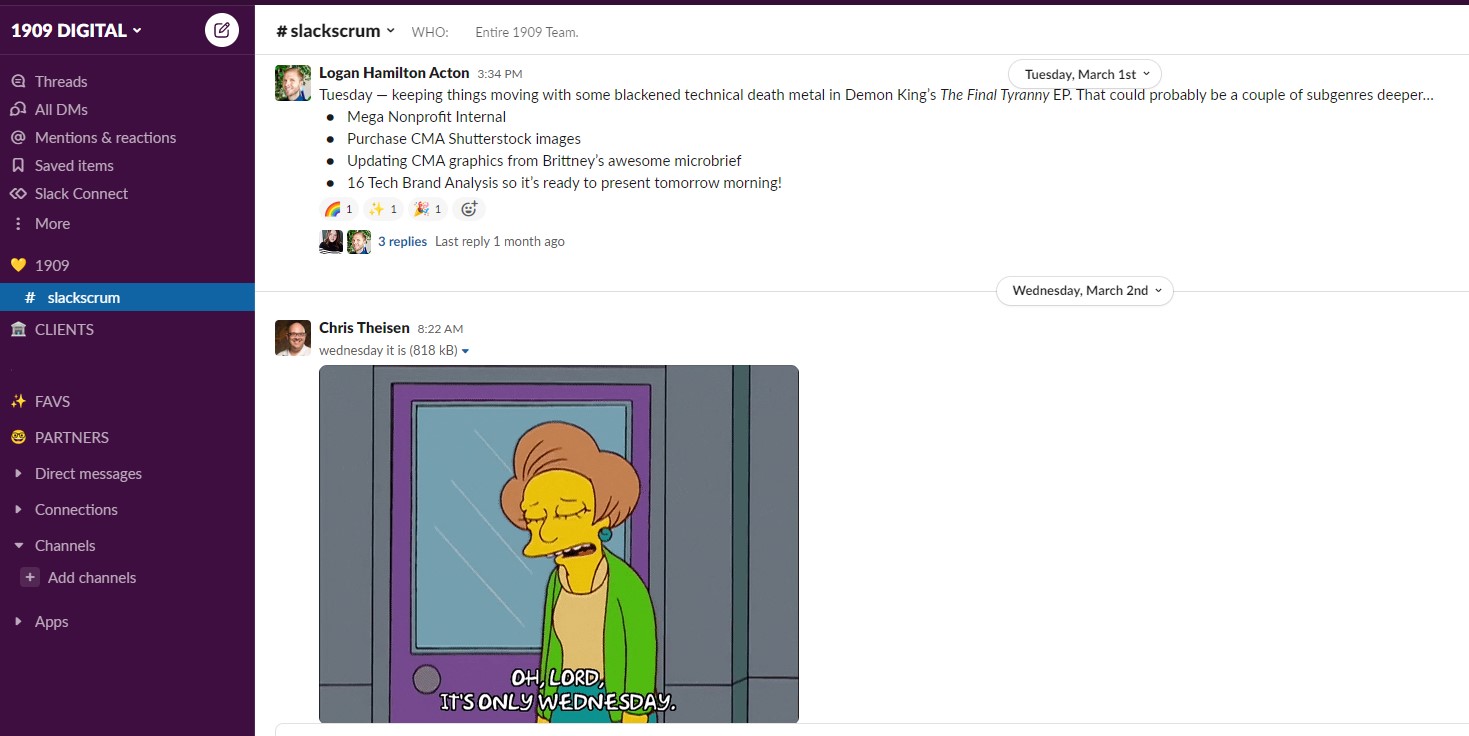Five tricks that keep our remote team tight-knit

We’re often asked, “Is it weird to work in an all-virtual office? How do you bond with your coworkers?”
1909 DIGITAL is a digital marketing agency with a true “pandemic world” pedigree. In 2019 our first home was the Speakeasy, a favorite local coworking space. By March 2020, the team expanded to support all of our clients going digital, leading to new team members from across the country. Now, 1909 is an all-remote team and plans to stay that way!
In 2020, many organizations went all-virtual and immediately struggled with feeling disconnected from colleagues. Team dynamics and work culture are important for us—we are built on avoiding the toxicity that pervaded our previous workplaces. We prioritize creating remote processes that allow us to feel closely connected to our team. Though some workplaces are returning to the office, remote or hybrid work is here to stay.
Beyond this, we also bring our clients into this digital-first culture through our day-to-day communications. In fact, we even started formal contracts for Digital Transformation to support our clients. Here’s how—with the help of Slack and Google Meets—1909 DIGITAL makes an all-remote culture work.
#1 Strike the Perfect Tone
It didn’t take us long to realize how useful Slack could be for our day-to-day communications. For the team, channels help us organize our chats by client and processes. It also provides us an informal space to connect about our lives and chat directly with one another. The most rewarding thing about Slack, however, has been bringing our clients onto the platform.
We call Slack our virtual version of “spinning your chair around.” In the office, you’re able to ask a colleague a quick question without an email or a phone call. With virtual teams, it’s not that easy. By inviting clients to their own Slack channel, we create a space for them to easily collaborate and ask questions. It’s the perfect communications channel for those items that need less formality than an email and more formality than a text.
Most importantly, these interactions help us build an easygoing, trusting relationship with our clients. It allows both sides to show our personalities and build rapport that would otherwise take weeks of scattered meetings to establish. From sharing pet pics, nerding out over the Marvel Cinematic Universe, or bonding over classic Neil Diamond—it can’t be all about digital marketing all the time!
#2 Forget Scrum. It’s #slackscrum!
We use an Agile methodology and work in two week sprints. In the earliest iteration of our workflow, we had full-team short video calls for daily scrums as well as one longer weekly kickoff meeting. A scrum is a 15-minute daily stand-up meeting where the team reviews tasks for that day and discusses “boulders” or what’s holding them up.
Our team’s many time zones made it difficult to schedule scrums. By the time our daily scrum happened, it was halfway through the east coast workday. We realized we had to change the way we coordinated work.
Enter #slackscrum! The solution was to creates a separate channel called #slackscrum to organize ourselves and go asynchronous with our daily updates. How does this work?
- Team members post their to-do list in the #slackscrum channel by 9:30 a.m. in their time zone every day.
- Other team members and Account Managers comment with questions and comments in a thread on each post. This affirms the status of projects and ensures that nothing is dropped.
- Some team members use the “strikethrough” feature to edit their task list throughout the day, which doubly illustrates where they are with tasks.
We still have virtual check-in meetings. But #slackscrum helps our video meetings are more efficient. We still maintain two video scrums on Wednesday and Thursday to dive more deeply into the status of projects. We see our coworkers at least once per day—which is more than some days we worked at in-person jobs!
#3 Reflect
Agile methodology encourages “retrospectives” at the end of each sprint. We take seriously John Dewey’s statement, “we do not learn from experience, we learn from reflecting on experience.”
We close each two-week sprint with a two hour-long planning meeting. Part of this meeting includes space to reflect on the past week and set intentions for the next week. We use online brainstorming tools to talk through our processes, share about the sprint’s ups and downs, and agree on how we can improve in the future.
Beyond crafting solutions, this time is essential for the team to celebrate success, vent about struggles, and bond about our shared experiences. Having the space to communicate in this way helps us build morale and strengthen relationships.
And when we’re not planning and reflecting in our group meeting, we’re doing the same in our weekly “one-on-ones.” These are thirty-minute meetings where each team member has individual time with one member of leadership. They smooth out project challenges, discuss day-to-day needs, and plan for professional development. This safe space is needed to ensure everyone is heard, always.
#4 Take the “First Five”
Our leadership team created a policy that serves us well for internal meetings (and even some client meetings!) The rule of “the First Five” is that the first five minutes of any internal meeting is reserved for off-topic chatter and breaks for necessities. Why formalize such a thing?
- It replaces the in-person “around the water cooler” office smalltalk.
- This catch-up time naturally occurs between meetings.
- That in-between time is lost when you go from video call to video call.
- Creating purposeful flexibility diminishes the guilt for “arriving late.”
- A limited time for purposeful smalltalk allows you to move on quickly.
- Any team member can call “First Five!” to remind us to get started.
We work really hard—but we acknowledge that people are human, and need breaks and social connections to be engaged and fulfilled with the work we do. “First five” exemplifies our down-to-earth “work-hard, play-hard” approach.

#5 Embrace gifs, emojis, and memes
The breakdown of team culture may very well be linked to the demise of inside jokes in our new, digital-first world. Tongue-in-cheek or not, embracing this natural tendency has helped us keep things light and stay tight knit. We liberally use gifs and emojis to lighten the vibe and bring some laughs. Our #random Slack channel has included anything from photos of family and pets to discussions about how many tabs we keep open at any given time. One team member shares the metal album that he’s grooving to that day. By using gifs and silly emojis to express ourselves, every team member is included in the social side of the remote work experience.
So what?
From 2020 to 2022, we’ve learned that the closeness of relationships doesn’t depend on physical proximity. Virtual workplaces are not inherently less connected. Communication matters—whether you’re virtual, in-person, or hybrid. We’ve worked hard to cultivate our workplace vibes, and we hope these tips can help your team too. Even if Slack isn’t for you, something as simple as a well-placed emoji can brighten up your day, and someone else’s.
This blog post was written by Alli Hartley-Kong.


